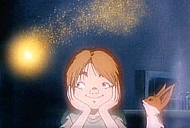
The Boy Who Saw The Wind
In the American anime scene, television shows are ruling the day. They easily snag viewers with their continuing storylines, and distributors are all too happy to have a property that will sell seven volumes instead of just one. For those of us who are film fans, however, it means that we are quickly running out of anime to watch...especially since the only movies with a good chance of being released here are either related to a television series (i.e. FullMetal Alchemist) or are by a renowned filmmaker (i.e. Hayao Miyazaki, Satoshi Kon). Since The Boy Who Saw The Wind has neither of these properties, I expect it to stay obscure for some time to come. Is that a bad thing? Not for the current generation of otaku who like anime to be all shiny and filled with fan service. But for those of us who appreciate slower-paced shows that looks and sounds old-school, The Boy Who Saw The Wind is worth tracking down.
Dr. Fritz is a renowned scientist who burns down his laboratory in order to keep the evil Branik from getting ahold of his latest research. Fritz's son, Amon, can summon an array of flowing light which can be used to heal or to harm. He also has the special ability to talk with animals. Though the kind boy has never even thought of doing evil with his gifts, Branik expects Dr. Fritz to create a new bomb from Amon's power. In his attempt to flee from Branik's Golden Snake Brigade, Amon finds himself far from home, learning that his power confirms him as one of the lost Wind Folk. Amon meets many new friends along his adventures, such as Urs the bear, who teaches him the stories of his ancestral past, and the young but brave Maria, who rescues him after an accident. However, Branik's insane lust for Amon's power keeps hurting those who the boy loves, and he realizes that he must stop running if he is to save those dearest to him. In the midst of a war between Branik's industrial machine and the nearby civilizations, Amon may be the only one who can bring an end to the madness.
The Boy Who Saw The Wind is a fine looking work for those who enjoy the look of anime before, say, the mid 1990s. The animation quality itself is high, with full motion and such, but the designs are dated and are perhaps intentionally so. The whole of the feature, including the moving orchestral score, brings back memories of the heyday of animated films in Japan. I wouldn't say that the movie looks impressive in the days of CGI this and CGI that, but it worked for me.
Of the few web sites that have reviewed this film, the comparison is always made to Hayao Miyazaki, and there is admittedly a debt to the master's work. From Amon's friend fox Myryu to the masks of the members of the Golden Snake Brigade, there are homages right and left. There's also a continuing environmental undertone to the film, something that Miyazaki includes in many of his films, and there are at least a couple of plot points that borrow from Nausicaa. The film is based on a book by C. W. Nicol, a Welsh ex-pat who has lived in Japan for over 40 years, so I don't know how much of the homage comes from the film's scriptwriter and director and how much comes from the original work. Unfortunately, the similarities have left some who have seen the film disappointed because it's not up to Miyazaki's standard. My question back is, what is?
The Boy Who Saw The Wind is primarily a plot movie; we move from point A to point B to point C because events demand it. Only a couple of the characters are fleshed out -- the good guys are good guys and the bad guys are bad guys and never the twain shall meet -- but that really didn't bother me. Amon, our protagonist, is a good mix of spunk and vigor without falling into the over-confidence of many anime heroes. Does the film stumble in not allowing our characters enough time for emotions? Yes, I admit that there's a bit of a failing there. Nevertheless, there is a sense of wonder and discovery throughout the film, and there are a few magic moments that left me enchanted. The film is still interested in the mystery of primitive religion and worlds where prayer is not a meaningless ritual, and there's a certain spiritual sense to it all that is intriguing (though it really doesn't represent any belief system in the modern world). The pacing is not a problem if you're expecting it to move a little slowly; there are plenty of action bits throughout, but the film is not told at breakneak speed. Once again, though, it may be a generational thing, because older anime films share its pacing.
Despite the general look of the film and the fact that its main characters are children, this is not a film for anyone under 10 or so. The violence is occasionally a little bloody and not just a little disturbing. If your child is still traumatized over Bambi's mother, don't consider it. But for a mature child finishing elementary school or an early middle schooler who has a bit of patience, it would probably be an exciting movie.
Though it's far from original and far from being a character study, The Boy Who Saw The Wind is a return to an earlier era of anime filmmaking that is refreshing for fans who've been around for a while. Engaging and exciting, it's definitely worth a download and even a purchase if it should finally find its way to your neck of the woods.
The Boy Who Saw The Wind -- realistic violence, brief non-descript nudity -- A-

